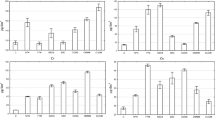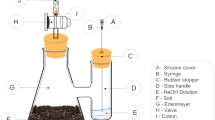Abstract
The primary methods for disposing of liquid pesticide wastes in California has been the dumping of the liquid materials into soil evaporation pits, ditches, and ponds. Many, if not most of these systems are unlined and have been in use for many years. One such soil pit located in northern California was found to be highly contaminated with an estimated level of >1 kg of active pesticide per 0.1 m3 of top soil. The top few cm of the bed contained an organic layer resembling slightly decomposed straw. The soil underlying the organic layer was clay, similar in texture to that typically found in rice growing areas. Both of these soil types were removed from the evaporation pit and placed in trays along side trays containing a similar soil type but free of pesticides. These latter trays were fortified with six pesticides and subjected to various soil amendments, including organic matter, lime, acids, and nutrients, under moist and flooded conditions for purposes of determining the optimum conditions for degrading high concentrations of pesticides in these soils. The effect of the soil amendments on the pesticide-fortified soils were generally pesticide dependent. The pH of the soils was a major factor in degradation but was different between the anaerobic and aerobic soils. Half lives of most pesticides was shorter with the highest pH soils under anaerobic conditions while the opposite was true with the aerobic treatments. The contaminated soils removed from the evaporation pit and treated with manure, ammonium phosphate and lime were very effective in reducing the half lives of the pesticides in both aerobic and anaerobic soils, as compared to corn meal and ammonium phosphate treatment. Alternating between moist and flooded soil conditions plus a heavy lime treatment combined with an organic source such as manure should provide an effective treatment for degrading pesticides in a contaminated toxic waste site.
Similar content being viewed by others
References
Alexander M (1977) Introduction to soil microbiology. 2nd Ed. John Wiley and Sons, New York, pp 467
Armstrong DE, Konrad JG (1974) Nonbiological degradation of pesticides. In: Gruenzi WO (ed) Pesticides In Soil and Water, Soil Science Society of America Inc, Madison, WI, pp 123–131
Getzin LW (1968) Persistence of diazinon and zinophos in soil: Effects of autoclaving, temperature, moisture, and acidity. J Econ Entomol 61:1560–1565
Hamaker JW (1972) Decomposition: quantitative aspects. In: Goring CAI, Hamaker JW (eds) Organic Chemicals in the Soil Environment, Vol 1, Marcel Dekker, New York pp253–340
Helling CS, Kearney PC, Alexander M (1971) Behavior of pesticides in soils. Adv Agronomy 23:147–240
Hurle K, Walker A (1980) Persistence and its prediction. In: Hence RJ (ed) Interactions Between Herbicides and the Soil Academic Press, New York, pp 83–122
Khan SU (1980) Pesticides in the Soil Environment. Elsevier, New York, pp 240
Schoen RS, Winterlin WL (1987) The effects of various soil factors and amendments on the degradation of pesticide mixtures. J Environ Sci Health B22:347–377
Smith TR, Atkinson K (1975) Techniques in Pedology. Paul Elek Scientific Books Ltd, London
Author information
Authors and Affiliations
Rights and permissions
About this article
Cite this article
Winterlin, W., Seiber, J.N., Craigmill, A. et al. Degradation of pesticide waste taken from a highly contaminated soil evaporation pit in California. Arch. Environ. Contam. Toxicol. 18, 734–747 (1989). https://doi.org/10.1007/BF01225011
Received:
Revised:
Issue Date:
DOI: https://doi.org/10.1007/BF01225011




